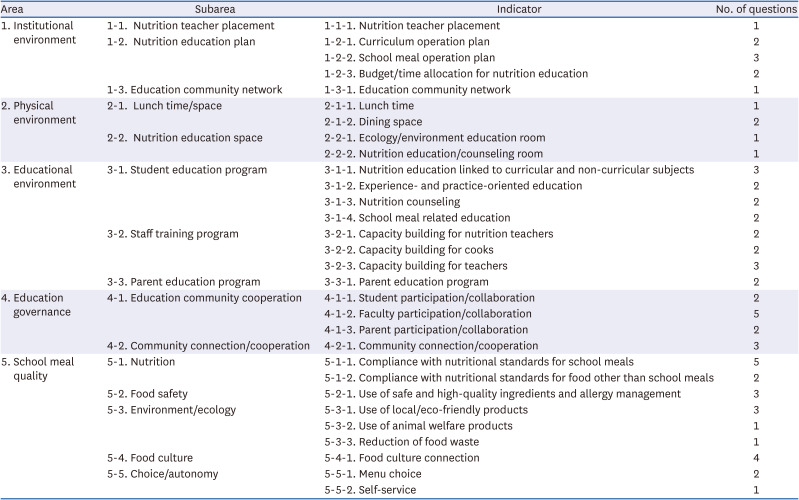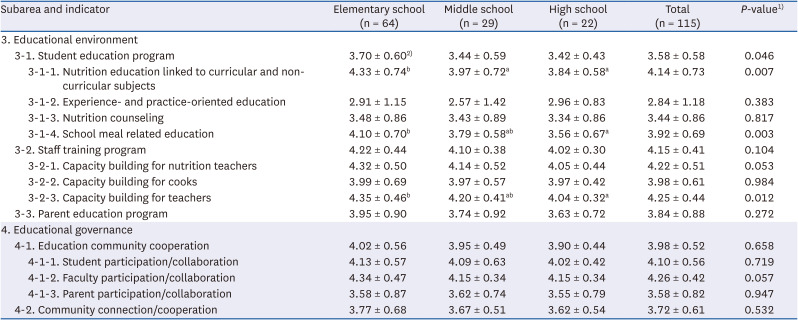1. Hart CS, Page A. The capability approach and school food education and culture in England: ‘gingerbread men ain’t gonna get me very far’. Camb J Educ. 2020; 50:673–693.
2. Storey HC, Pearce J, Ashfield-Watt PA, Wood L, Baines E, Nelson M. A randomized controlled trial of the effect of school food and dining room modifications on classroom behaviour in secondary school children. Eur J Clin Nutr. 2011; 65:32–38. PMID:
20978529.
3. Faught EL, Gleddie D, Storey KE, Davison CM, Veugelers PJ. Healthy lifestyle behaviours are positively and independently associated with academic achievement: an analysis of self-reported data from a nationally representative sample of Canadian early adolescents. PLoS One. 2017; 12:e0181938. PMID:
28753617.
4. Ministry of Education (KR). The 5th School Meal Hygiene Management Guidelines. Sejong: Ministry of Education;2021.
5. The Korean Educational Development Institute. School Meal Satisfaction Survey. Jincheon: The Korean Educational Development Institute;2018.
6. Na HL, Kim MH, Choi MK. Evaluation of sanitary education and performance of sanitary management among school food service employees in Sejong. J Korean Diet Assoc. 2019; 25:17–29.
7. Seo YH, Moon KD. Monitoring and risk assessment of pesticides in school foodservice products in Seoul, Korea. Korean J Food Preserv. 2014; 21:69–74.
8. Kim YS, Kim BH, Kim KA, Kim DH, Yun HJ, Kwak SH, Kang KJ, Cho WH, Moh AR, Choi OK, et al. Safety assessment of biogenic amines in school-meal fishery products. J Food Hyg Saf. 2020; 35:125–135.
9. Kim JH, Kim HS. A survey on the satisfaction of middle school students with school meals and their food preferences. J Korea Contents Assoc. 2016; 16:488–496.
10. Lee KY, Bae YJ, Choi MK, Kim MH. Satisfaction on school meal service and food preference of elementary school students in Chungnam. Korean J Food Nutr. 2017; 30:129–138.
11. Soil Association. The Food for Life Schools Award [Internet]. Edinburgh: Soil Association;2024. cited 2024 March 11. Available from:
https://www.foodforlife.org.uk/.
13. Roos G. One size fits all? – differences in school food cultures identified in iPOPY research. Mikkelsen BE, He C, Mikkola M, Nielsen T, Nymoen LL, editors. CORE Organic Project Series Report. Tjele: ICROFS;2009. p. 54–56.
14. Action For Healthy Kids. Action For Healthy Kids’ website [Internet]. Skokie (IL): Action For Healthy Kids;2024. cited 2024 March 11. Available from:
https://www.actionforhealthykids.org/.
15. Great Schools Partnership. The glossary of education reform [Internet]. Portland: Great Schools Partnership;2014. cited 2024 March 11. Available from:
https://www.edglossary.org/.
16. Kim MJ, Lee HM. Analysis of school culture research trends in Korea. J Yeolin Educ. 2015; 23:255–284.
17. The Scottish Government. Better Eating, Better Learning: Self-Evaluation Tool. Edinburgh: The Scottish Government;2014.
18. Department for Education (UK). Healthy Schools Rating Scheme: Guidance for Schools. London: Department for Education;2019.
19. Ministry of Education (KR). Status of school lunch program in Korea [Internet]. Sejong: Ministry of Education;2023. cited 2023 December 10. Available from:
https://www.moe.go.kr.
20. Wellness School Assessment Tool. Wellness School Assessment Tool’s website [Internet]. Connecticut: Wellness School Assessment Tool;2021. cited 2024 March 11. Available from:
https://www.wellsat.org/.
21. Food for Life. Food for Life Partnership [Internet]. Bristol: Food for Life;2024. cited 2024 March 11. Available from:
https://www.foodforlife.org.uk/.
22. Lawshe CH. A quantitative approach to content validity. Person Psychol. 1975; 28:563–575.
23. Denman S. Health promoting schools in England--a way forward in development. J Public Health Med. 1999; 21:215–220. PMID:
10432253.
24. The Korean Law Information Center. Enforcement Decree of the School Meal Act, Duties of Nutrition Teachers. Sejong: The Korean Law Information Center;2021.
25. Lee KH, Choi BS, Lee IS. Job satisfaction and perception of importance-performance among nutrition counseling by nutrition teachers in Kyungbuk area. 2010; 20:1018–1028.
26. Hart CS. The School Food Plan and the social context of food in schools. Camb J Educ. 2016; 46:211–231.
27. Stroebele N, De Castro JM. Effect of ambience on food intake and food choice. Nutrition. 2004; 20:821–838. PMID:
15325695.
28. Sahota P, Woodward J, Molinari R, Pike J. Factors influencing take-up of free school meals in primary- and secondary-school children in England. Public Health Nutr. 2014; 17:1271–1279. PMID:
23578731.
29. Golley R, Baines E, Bassett P, Wood L, Pearce J, Nelson M. School lunch and learning behaviour in primary schools: an intervention study. Eur J Clin Nutr. 2010; 64:1280–1288. PMID:
20808337.
30. Marcano-Olivier MI, Horne PJ, Viktor S, Erjavec M. Using nudges to promote healthy food choices in the school dining room: a systematic review of previous investigations. J Sch Health. 2020; 90:143–157. PMID:
31852016.
31. Moore SN, Murphy S, Tapper K, Moore L. The social, physical and temporal characteristics of primary school dining halls and their implications for children’s eating behaviors. Health Educ. 2010; 110:399–411.
32. Varman SD, Cliff DP, Jones RA, Hammersley ML, Zhang Z, Charlton K, Kelly B. Experiential learning interventions and healthy eating outcomes in children: a systematic literature review. Int J Environ Res Public Health. 2021; 18:10824. PMID:
34682570.
33. Dimbleby H, Vincent J. The School Food Plan. London: Department for Education (UK);2013.
34. Parmer SM, Salisbury-Glennon J, Shannon D, Struempler B. School gardens: an experiential learning approach for a nutrition education program to increase fruit and vegetable knowledge, preference, and consumption among second-grade students. J Nutr Educ Behav. 2009; 41:212–217. PMID:
19411056.
35. Gyeonggido Office of Education. Autonomous Choice Meal Service Evaluation Report. Suwon: Gyeonggido Office of Education;2023.
36. Parsons C, Stears D, Thomas C. The health promoting school in Europe: conceptualising and evaluating the change. Health Educ J. 1996; 55:311–321.
37. Jones M, Pitt H, Oxford L, Bray I, Kimberlee R, Orme J. Pupil Survey in Local Commission Areas: Food for Life’s Impact on Primary School Children’s Consumption of Fruit and Vegetables. Full Report. Bristol: University of the West of England;2015.











 PDF
PDF Citation
Citation Print
Print



 XML Download
XML Download